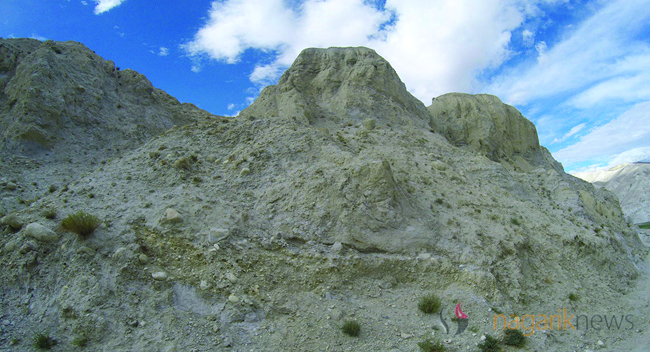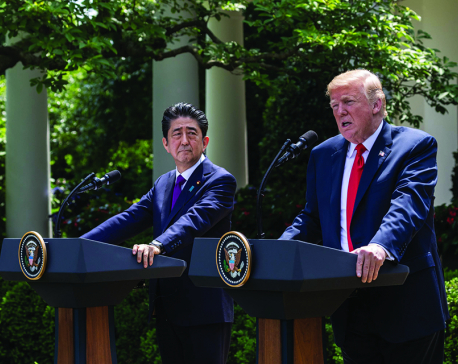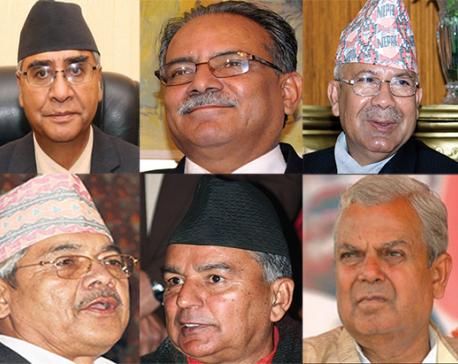
OR


Dr Mahesh K Maskey
The author, former Ambassador of Nepal to China, is also a former Vice President of International Physicians for Prevention of Nuclear Warnews@myrepublica.com
US-Iran conflict is escalating into a trigger-ready brinkmanship leading to a palpable fear of another Middle-East war. The democrat-led US House has recently passed a “Defense Authorization Bill” to restrain President Trump from attacking Iran, but there is little room for respite. US marines have just been deployed in Saudi Arabia’s base while Stealth F22 was already stationed in Qatar. Iran has also increased its pitch about war preparation—Strait of Hormuz being the theatre for show of muscle by both countries. However, the most worrisome scenario is the implied threats of the use of nuclear weapons and the explicit warning of uranium enrichment.
Unfolding of this horror story began a year ago with the US withdrawal from Iran nuclear accord. The conflict dragged on to the present standoff in spite of continued efforts of Russia, China, France, UK and Germany to salvage it. Crushed under the suffocating US economic sanctions that claimed to bring export of oil to zero, Iran retaliated with the threat of uranium enrichment beyond the limit set by the Accord. In July 7, Iran crossed that limit. This disclosure has thrown the world in a state of panic and a frenzy of activities to contain the lurking possibility of development of nuclear weapons. International Atomic Energy Agency (IAEA) and UN Security Council are pushed to the forefront to diffuse and de-escalate the situation. The war of words has firmly embedded ‘Uranium Enrichment’ in popular consciousness, globally.
Reason to worry
Nepal ought to watch these events closely and carefully not only to prepare for rescue of Nepali workers if situation gets worse, but also because its leaders are bent on uranium mining and enrichment. Nepal’s imprudent and reckless Nuclear Bill, which is being hotly debated in the parliament and media, is giving permission for uranium enrichment far too greater than the limit set by Iran Accord. In fact, Nepal begins from where Iran threatens to arrive—a uranium enrichment of less than 20 percent. The limit set by Iran Accord was less than four percent. Iran has now crossed this bar to just five percent. So should we say Nepal is ‘quite lucky’ to get permission for this level of uranium enrichment, whereas Iran risks war for attempting for the same?
The dangers inherent in these numbers compel us to understand their meaning and to compare Iran with Nepal through the lens of uranium enrichment. Natural Uranium is a combination of 99.3 percent U-238, and 0.7 percent U-235 isotopes. The latter is the prize element for electricity production, radioisotope production and the nuclear bomb. Electricity generation from nuclear reactor needs less than four percent enriched uranium as fuel. This means the uranium contains less than four percent U-235 and the rest is U-238. That is the limit set for Iran (3.67 percent). Nepal’s nuclear bill grants a starter of less than 20 percent because for medical and other radioisotopes productions enriched uranium of less than 20 percent to 90 percent is needed.
Less than 20 percent is called Lowly Enriched Uranium (LEU). More than 20 percent is called Highly Enriched Uranium (HEU). When HEU is 90 percent or more it is called weapon grade material used to make nuclear bombs. The proponents of the nuclear bill of Nepal have made it clear that the bill is not for electricity production. It is for the manufacture of medical and other radioisotopes. Hence, even if Nepal is to be confined to LEU as the current global trend is for radioisotope production, and not allowed to go for HEU, it would still need enriched uranium less than 20 percent. That means Nepal should have the proper facility to enrich the uranium to less than 20 percent.
Now here is the catch. To produce the medical and other isotope and to produce enriched uranium are two entirely different processes. Nuclear research reactor provision in the Bill is for the production of these radio-isotopes by irradiating enriched uranium ‘targets’ in the reactor. But the fact hidden from the public eye is that we do not need uranium or the reactor to produce needed radioisotopes. We are fortunately living in a time when there is a cheaper and safer alternative, a non-uranium and non-reactor way to produce these isotopes by Cyclotron. But the Ministry and National Academy of Science and Technology (NAST) has turned deaf ear to this alternative, clamoring only for the need of uranium and research reactors and Nuclear Research Center.
Hiding the truth
By now there is no shred of doubt that the rubric of Nuclear Research Center (NRC) as the rationale behind the nuclear bill touted by Ministry of Education, Science and Technology is only a fig leaf to hide the real intention. Establishment of this research center was not mentioned in the Bill when it was presented in the parliament. It was introduced as revision proposal after it was submitted to the Parliament to fence off the rising criticism when pointed out that the word or concept of NRC does not exist in the Bill.
NRC is a welcome event if it wants to do research for production of medical and other isotopes or study particle physics. But it can do so without using uranium or nuclear reactors. Particle accelerators such as Cyclotrons are mainstay of such research centers. The nuclear or medical physicists or chemists of Nepal know this fact very well. But they have chosen to shut their mouth and conscience. In recent articles some are found to argue that since we are surrounded by nuclear nations, Nepal should also follow suit, there is no alternative and so on.
The real intent behind the facade of Nuclear Research Center, therefore, as anybody can see, is mining of uranium, its enrichment and use in a nuclear reactor and export enriched uranium and their products across the border. The Bill, if passed as Act, grants legal permission to individual bidders or the state to carry out all these steps in the name of science and technology, something Iran can only venture to dream. Why would Nepal, a country which has not been able to even properly handle safety guidance of X-ray machines, be privileged to have this dispensation from International Atomic Energy Agency (IAEA)?
This question now needs to be put not only to Nepal government but also to IAEA because if something untoward happens, this organization is called upon for resolution as shown by US-Iran uranium row. Nepali people have the right to know from its government and international agencies why Nepal is being encouraged to tread this dangerous path of uranium enrichment where other countries have been prohibited. Why this colossal step toward polluting our pristine, precious and fragile environment from uranium related radio-active pollution that remains for millions of years, when Nepal is making sincere effort to prevent climate change related environmental disaster? Why such mined and enriched nuclear materials are envisioned to export across a geopolitically sensitive country like ours, when we are aspiring for a neighborhood policy of peace and friendship?
Uranium for peace?
The maxim of International Atomic Energy Agency is “Atom for Peace and Development.” This phrase is drawn from the famous “Atom for Peace” speech delivered by US president Dwight Eisenhower in 1953. Before his speech the atomic issues were kept hidden from the public eye. Eisenhower aspired to solve “the fearful atomic dilemma” by finding ways by which “the miraculous inventiveness of man would not be dedicated to his death, but consecrated to his life.”
Unfortunately, as history was to witness, Eisenhower was not successful in this goal and he himself approved the National Security Council (NSC) document that justified a massive atomic weapon base to deter probable attack from the Soviet Union. During his time in office (1953-1961), the US nuclear weapon rose from 1000 to 20,000. Estimates of increase in USSR nuclear weapons in the same period are from 100 to 2500. It was the beginning of Cold War with Soviet Russia.
In 1957, IAEA was established to carry out the formidable task of harnessing atom for peaceful use and to prevent the development of nuclear weapons. But it can be said that use of atom since then has been more for perpetuating the shadows of nuclear war than for the peace and development. Critics point out that while the US initiative for “Atoms for Peace” created the ideological background for the creation of International Atomic Energy Agency and Treaty on the Non-Proliferations of Nuclear Weapons, it also gave political cover for the US and Russian nuclear weapon build-up. Under programs related to Atoms for Peace, the US exported over 25 tons of highly enriched uranium (HEU) to 30 countries, mostly to fuel research reactors and is now regarded as a proliferation and terrorism risk. Under a similar program, the Soviet Union exported over 11 tons of HEU. Mention of “research reactors” is noteworthy here since that is what the Nuclear Bill strives to establish in Nepal.
We may recall when India was naming its first atomic bomb in 1974 made from the plutonium byproduct of its research reactors they called it “Smiling Buddha.” Since Buddha’s name is synonymous with peace it was perhaps a perverse way to suggest India’s joining of the club of nuclear nations in the spirit of ‘atom for peace.’
We pride in being holy birth place of Gautam Buddha, and the bearer of his message of peace and the love for the environment. Our leaders speak of this all the time. Given this and the trend of reasoning that flows from the protagonist of the nuclear bill, it would not be surprising if, one fine morning, we are told that this whole uranium thing in Nepal is in fact Buddha’s ‘message for peace,’ however perverse it may sound.
maskeymk8@gmail.com
You May Like This

China, Japan, and Trump’s America
It is difficult to remember that a little over two decades ago, many Americans feared being overtaken by Japan, not... Read More...

No country for new leaders
Obama became the US president 13 years after Deuba became Nepal’s prime minister in 1995. When Jhalanath Khanal became UML’s... Read More...

Why privacy bill should be amended
The state has no right to control people’s freedom and liberties while introducing right to privacy laws. No law should... Read More...




Just In
- CM Kandel requests Finance Minister Pun to put Karnali province in priority in upcoming budget
- Australia reduces TR visa age limit and duration as it implements stricter regulations for foreign students
- Govt aims to surpass Rs 10 trillion GDP mark in next five years
- Govt appoints 77 Liaison Officers for mountain climbing management for spring season
- EC decides to permit public vehicles to operate freely on day of by-election
- Fugitive arrested after 26 years
- Indian Potash Ltd secures contract to bring 30,000 tons of urea within 107 days
- CAN adds four players to squad for T20 series against West Indies 'A'














Leave A Comment